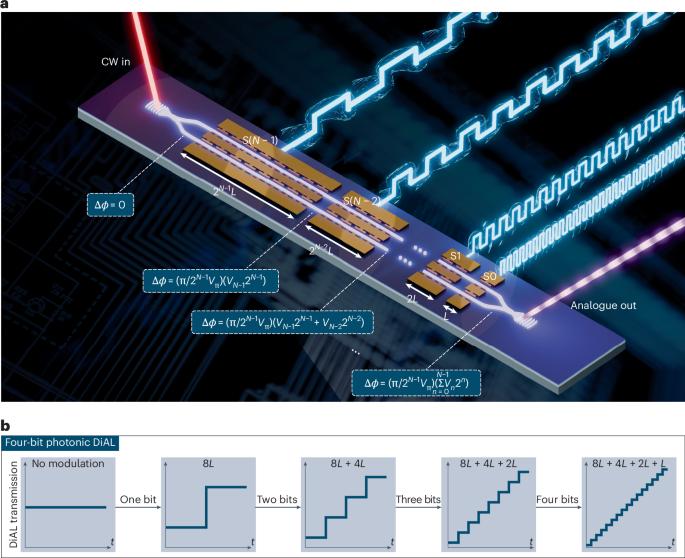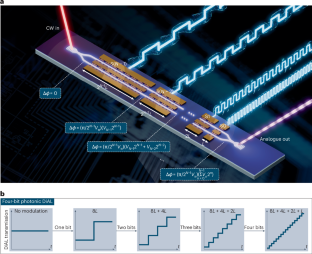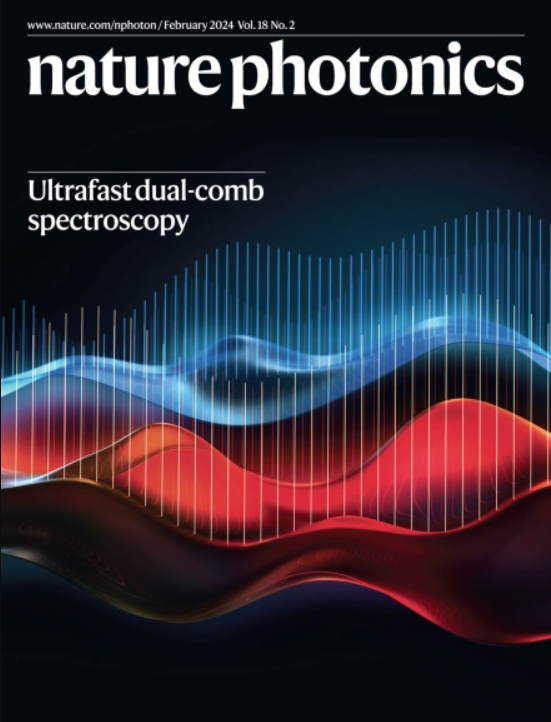Integrated electro-optic digital-to-analogue link for efficient computing and arbitrary waveform generation
IF 32.9
1区 物理与天体物理
Q1 OPTICS
引用次数: 0
Abstract
The rapid growth in artificial intelligence and modern communication systems demands innovative solutions for increased computational power and advanced signalling capabilities. Integrated photonics, leveraging the analogue nature of electromagnetic waves at the chip scale, offers a promising complement to approaches based on digital electronics. To fully unlock their potential as analogue processors, establishing a common technological base between conventional digital electronics and analogue photonics is imperative for building next-generation computing and communications systems. However, the absence of an efficient interface has thus far critically challenged a comprehensive demonstration of the advantages of analogue photonic hardware, with the scalability, speed and energy consumption as primary bottlenecks. Here we address this challenge and demonstrate a general electro-optic digital-to-analogue link enabled using foundry-based lithium niobate nanophotonics. Using purely digital electronic inputs, we achieve the on-demand generation of both analogue optical and electronic waveforms at information rates of up to 186 Gb s−1. The optical waveforms address the digital-to-analogue electro-optic conversion challenge in photonic computing, showcasing high-fidelity Modified National Institute of Standards and Technology image encoding with an ultralow power consumption of 0.058 pJ b−1. The electronic waveforms enable a pulse-shaping-free microwave arbitrary waveform generation method with ultrabroadband tunable delay and gain. Our results pave the way for efficient and compact digital-to-analogue conversion paradigms enabled by integrated photonics, and underscore the transformative impact that analogue photonic hardware may have on various applications, such as computing, optical interconnects and high-speed ranging. Using the well-established foundry-based lithium niobate nanophotonics platform, a general electro-optic digital-to-analogue link with ultrahigh bandwidth (>150 Gb s−1) and ultralow power consumption (0.058 pJ b−1) is demonstrated, providing a direct, energy-efficient, high-speed and scalable solution for interfacing digital electronics and photonics.


集成电光数模链路,用于高效计算和任意波形生成
人工智能和现代通信系统的快速发展需要创新的解决方案来提高计算能力和先进的信号能力。集成光子学,在芯片尺度上利用电磁波的模拟性质,为基于数字电子学的方法提供了一个有前途的补充。为了充分释放它们作为模拟处理器的潜力,在传统数字电子学和模拟光子学之间建立一个共同的技术基础对于构建下一代计算和通信系统是必不可少的。然而,到目前为止,由于缺乏有效的接口,模拟光子硬件的优势的全面展示受到了严峻的挑战,可扩展性、速度和能耗是主要瓶颈。在这里,我们解决了这一挑战,并展示了一种通用的电光数模链路,该链路使用基于铸造厂的铌酸锂纳米光子学实现。使用纯数字电子输入,我们以高达186 Gb s−1的信息速率实现了模拟光学和电子波形的按需生成。光波形解决了光子计算中数模电光转换的挑战,展示了高保真的修改的美国国家标准与技术研究所图像编码,超低功耗为0.058 pJ b−1。电子波形实现了一种无脉冲形状的微波任意波形产生方法,具有超宽带可调延迟和增益。我们的研究结果为集成光子学实现高效、紧凑的数模转换范式铺平了道路,并强调了模拟光子硬件可能对各种应用(如计算、光互连和高速测距)产生的变革性影响。
本文章由计算机程序翻译,如有差异,请以英文原文为准。
求助全文
约1分钟内获得全文
求助全文
来源期刊

Nature Photonics
物理-光学
CiteScore
54.20
自引率
1.70%
发文量
158
审稿时长
12 months
期刊介绍:
Nature Photonics is a monthly journal dedicated to the scientific study and application of light, known as Photonics. It publishes top-quality, peer-reviewed research across all areas of light generation, manipulation, and detection.
The journal encompasses research into the fundamental properties of light and its interactions with matter, as well as the latest developments in optoelectronic devices and emerging photonics applications. Topics covered include lasers, LEDs, imaging, detectors, optoelectronic devices, quantum optics, biophotonics, optical data storage, spectroscopy, fiber optics, solar energy, displays, terahertz technology, nonlinear optics, plasmonics, nanophotonics, and X-rays.
In addition to research papers and review articles summarizing scientific findings in optoelectronics, Nature Photonics also features News and Views pieces and research highlights. It uniquely includes articles on the business aspects of the industry, such as technology commercialization and market analysis, offering a comprehensive perspective on the field.
 求助内容:
求助内容: 应助结果提醒方式:
应助结果提醒方式:


